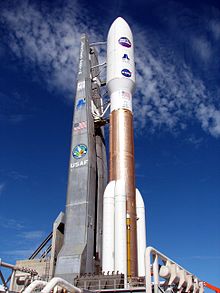


Uranus Pathfinder was a mission concept for the Uranian system evaluated in the 2010s by the European Space Agency. [1] In 2011, scientists from the Mullard Space Science Laboratory in the United Kingdom proposed the joint NASA–ESA Uranus Pathfinder mission to Uranus. It would have been a medium-class (M-class) mission to be launched in 2022, and was submitted to the ESA in December 2010 with the signatures of 120 scientists from around the globe. ESA caps the cost of M-class missions at €470 million. [2] [3] [4] Uranus Pathfinder was proposed in support of ESA's Cosmic Vision 2015–2025. [5] The mission study including several possible combinations of launch dates, trajectories, and flybys (gravity assists), including flybys of Earth, Venus, and of the planet Saturn. [6] Indeed, the study noted the velocity change requirements are only marginally higher than for typical missions to Saturn of this period. [7]
In the baseline concept, UP is an ESA–NASA bilateral mission and it would launch on an Atlas V 551 in January 2025 on a Venus–Earth–Earth interplanetary transfer to Uranus, reaching Uranus orbit in November 2037 after a cruise phase lasting 12.8 years.
It would orbit Uranus in a highly eccentric 45-day polar science orbit, with close periapsis distances to Uranus to make high-fidelity measurements of Uranus's gravitational and magnetic fields.
The scientific payload has a strong heritage in Europe and beyond and includes: a narrow-angle camera, visible/near-IR imaging spectrometer, thermal IR bolometer, radio science, magnetometer, radio and plasma wave detector, and plasma detector.
The mission would use the Earth communication stations at New Norcia ( X band), and Cebreros (X and Ka bands) during its long cruise to the Uranian system. [8]
Possible flyby/ gravity assist combinations studied: [9]
- VVE (Venus–Venus–Earth)
- VEE
- EVVE
- VEES (Venus–Earth–Earth–Saturn)
- VVEES
For power, the proposal suggests using a European radioisotope thermoelectric generator based on americium-241, with NASA's MMRTG and ASRG mentioned as possible backup options, which would provide more power. [10]
- Uranus mission proposals
- ^ Schirber, Michael (13 October 2011). "Missions Proposed to Explore Mysterious Tilted Planet Uranus". Space.com / Astrobiology Magazine.
- ^ Arridge, Chris (21 April 2011). "Uranus Pathfinder: Exploring the Origins and Evolution of Ice Giant Planets".
- ^ Sutherland, Paul (January 7, 2011). "Scientists plan Uranus probe". Christian Science Monitor.
- ^ "Call for a Medium-size mission opportunity for a launch in 2022". ESA. 29 Jul 2010. Retrieved 7 March 2023.
- ^ [1] (Line 205)
- ^ [2] (Line 562–4)
- ^ [3] (Line 562–4)
- ^ [4] (Line 634)
- ^ [5] (Line 562–4)
- ^ [6] (738–748)



Uranus Pathfinder was a mission concept for the Uranian system evaluated in the 2010s by the European Space Agency. [1] In 2011, scientists from the Mullard Space Science Laboratory in the United Kingdom proposed the joint NASA–ESA Uranus Pathfinder mission to Uranus. It would have been a medium-class (M-class) mission to be launched in 2022, and was submitted to the ESA in December 2010 with the signatures of 120 scientists from around the globe. ESA caps the cost of M-class missions at €470 million. [2] [3] [4] Uranus Pathfinder was proposed in support of ESA's Cosmic Vision 2015–2025. [5] The mission study including several possible combinations of launch dates, trajectories, and flybys (gravity assists), including flybys of Earth, Venus, and of the planet Saturn. [6] Indeed, the study noted the velocity change requirements are only marginally higher than for typical missions to Saturn of this period. [7]
In the baseline concept, UP is an ESA–NASA bilateral mission and it would launch on an Atlas V 551 in January 2025 on a Venus–Earth–Earth interplanetary transfer to Uranus, reaching Uranus orbit in November 2037 after a cruise phase lasting 12.8 years.
It would orbit Uranus in a highly eccentric 45-day polar science orbit, with close periapsis distances to Uranus to make high-fidelity measurements of Uranus's gravitational and magnetic fields.
The scientific payload has a strong heritage in Europe and beyond and includes: a narrow-angle camera, visible/near-IR imaging spectrometer, thermal IR bolometer, radio science, magnetometer, radio and plasma wave detector, and plasma detector.
The mission would use the Earth communication stations at New Norcia ( X band), and Cebreros (X and Ka bands) during its long cruise to the Uranian system. [8]
Possible flyby/ gravity assist combinations studied: [9]
- VVE (Venus–Venus–Earth)
- VEE
- EVVE
- VEES (Venus–Earth–Earth–Saturn)
- VVEES
For power, the proposal suggests using a European radioisotope thermoelectric generator based on americium-241, with NASA's MMRTG and ASRG mentioned as possible backup options, which would provide more power. [10]
- Uranus mission proposals
- ^ Schirber, Michael (13 October 2011). "Missions Proposed to Explore Mysterious Tilted Planet Uranus". Space.com / Astrobiology Magazine.
- ^ Arridge, Chris (21 April 2011). "Uranus Pathfinder: Exploring the Origins and Evolution of Ice Giant Planets".
- ^ Sutherland, Paul (January 7, 2011). "Scientists plan Uranus probe". Christian Science Monitor.
- ^ "Call for a Medium-size mission opportunity for a launch in 2022". ESA. 29 Jul 2010. Retrieved 7 March 2023.
- ^ [1] (Line 205)
- ^ [2] (Line 562–4)
- ^ [3] (Line 562–4)
- ^ [4] (Line 634)
- ^ [5] (Line 562–4)
- ^ [6] (738–748)
